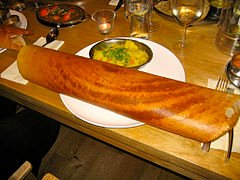dosa

A dosa (also dosai or dosha) is a thin pancake or crepe, originating from South India, made from a fermented batter predominantly consisting of lentils and rice. It is somewhat similar to a crepe in appearance, although savoury flavours are generally emphasized (sweet variants also exist). Its main ingredients are rice and black gram, ground together in a fine, smooth batter with a dash of salt, then fermented. Dosas are a common dish in South Indian cuisine, but now have become popular all over the Indian subcontinent. Dosas are served hot along with chutney by tradition and sambar in recent times. Other accompaniments include chutney powder (a fine groundnut and lentil powder).
.jpg)
History of Dosa
Dosas originated in South India; their exact birthplace in that region is a matter of conjecture.[1] In ancient times the millets were the staple food of South Indian region and not the paddy/rice. From ancient literature, scriptures and stone edicts it can be found that the rice originated from Ancient Tamilakam. The ancient Chola Nadu region is known to be the rice bowl. Most of the present day dishes like idli, dosai, appam, pittu/puttu are referenced in the ancient Tamil Sangam literature. Rice based dishes spread to rest of the South Indian region from Tamilakam. According to food historian K. T. Achaya, dosa (as dosai) was already in use in the ancient Tamil country around the 1st century AD, as per references in the Sangam literature.[2] According to historian P. Thankappan Nair, dosa originated in the Udupi town of present-day Karnataka.

In popular tradition, the origin of the dosa is linked to Udupi, probably because of the dish's association with the Udupi restaurants. Also, the original Tamil dosai was softer and thicker. The thinner and crispier version of dosai was first made in present-day Karnataka.[5] A recipe for dosa (as dosaka) can be found in Manasollasa, a 12th-century Sanskrit encyclopedia compiled by the Chalukya king Someshvara III, who ruled from present-day Karnataka.
After the Independence of India, South Indian cuisine became gradually popular in the North. In Delhi the Madras Hotel in Connaught Place became a landmark that was one of the first restaurants to serve South Indian cuisine. It arrived in Mumbai with the Udupi restaurants in the 1930s.
.jpg)
Nutrition
Dosa is high in carbohydrates and contains no added sugars or saturated fats. As its key ingredients are rice and black gram, it is also a good source of protein. One home made plain dosa without oil contains about 112 calories, of which 84% is carbohydrate and 16% protein. The fermentation process increases the vitamin B and vitamin C content. There are instant mix products for making dosa which usually contain higher levels of rice.
.jpg)
Serving
Dosa can be stuffed with fillings of vegetables and sauces to make a quick meal. They are typically served with a vegetarian side dish which varies according to regional and personal preferences. Common side items are:
• Sambar
• Chutney: examples include coconut chutney (a semi-solid paste made up of coconut, dal (lentils), green chilli and mint or coriander)
• There are varieties of chutney served along with Dosa[14]
• Idli podi or milagaipodi (in Tamil): a lentil powder with spices and sometimes desiccated coconut, mixed with sesame oil or groundnut oil or ghee
• Indian pickles
.jpg)
Variations
The most popular version is the masala dosa, with a filling of the potato masala. Mysore masala is the spicier version of it. Sada (plain) is without filling; paper dosa is a thin and crisp version. Rava dosa is made crispier using semolina.[15] Newer recipes have been developed that use fusion, like Chinese dosa, cheese dosa, paneer dosa and many more.
.jpg)
Please don't perform General Posting here as This is meant for Achievement Program :)
You can post over Steemit Nursery for better engagement ! :)
After getting verified over Achievement 1